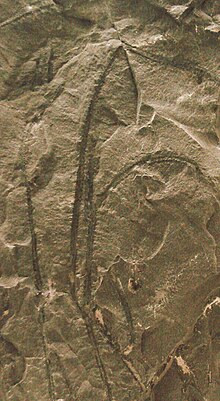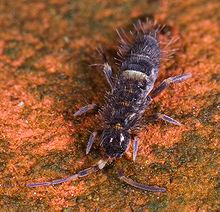The Devonian Portal
The Devonian (/dəˈvoʊni.ən, dɛ-/ də-VOH-nee-ən, deh-) is a geologic period which was a system of the Paleozoic era during the Phanerozoic eon, spanning 60.3 million years from the end of the preceding Silurian period at 419.2 million years ago (Ma), to the beginning of the succeeding Carboniferous period at 358.9 million years ago. It is named after Devon, South West England, where rocks from this period were first studied.
The first significant evolutionary radiation of life on land occurred during the Devonian, as free-sporing land plants (pteridophytes) began to spread across dry land, forming extensive coal forests which covered the continents. By the middle of the Devonian, several groups of vascular plants had evolved leaves and true roots, and by the end of the period the first seed-bearing plants (pteridospermatophytes) appeared. This rapid evolution and colonization process, which had begun during the Silurian, is known as the Silurian-Devonian Terrestrial Revolution. The earliest land animals, predominantly arthropods such as myriapods, arachnids and hexapods, also became well-established early in this period, after beginning their colonization of land at least from the Ordovician period.
Fishes, especially jawed fish, reached substantial diversity during this time, leading the Devonian to often be dubbed the Age of Fishes. The armored placoderms began dominating almost every known aquatic environment. In the oceans, cartilaginous fishes such as primitive sharks became more numerous than in the Silurian and Late Ordovician. Tetrapodomorphs, which include the ancestors of all four-limbed vertebrates (i.e. tetrapods), began diverging from freshwater lobe-finned fish as their more robust and muscled pectoral and pelvic fins gradually evolved into forelimbs and hindlimbs, though they were not fully established for life on land until the Late Carboniferous. (Full article...)
Selected Devonian Article
The Late Devonian extinction consisted of several extinction events in the Late Devonian Epoch, which collectively represent one of the five largest mass extinction events in the history of life on Earth. The term primarily refers to a major extinction, the Kellwasser event, also known as the Frasnian-Famennian extinction, which occurred around 372 million years ago, at the boundary between the Frasnian stage and the Famennian stage, the last stage in the Devonian Period. Overall, 19% of all families and 50% of all genera became extinct. A second mass extinction called the Hangenberg event, also known as the end-Devonian extinction, occurred 359 million years ago, bringing an end to the Famennian and Devonian, as the world transitioned into the Carboniferous Period.
Although it is well established that there was a massive loss of biodiversity in the Late Devonian, the timespan of this event is uncertain, with estimates ranging from 500,000 to 25 million years, extending from the mid-Givetian to the end-Famennian. Some consider the extinction to be as many as seven distinct events, spread over about 25 million years, with notable extinctions at the ends of the Givetian, Frasnian, and Famennian stages.
By the Late Devonian, the land had been colonized by plants and insects. In the oceans, massive reefs were built by corals and stromatoporoids. Euramerica and Gondwana were beginning to converge into what would become Pangaea. The extinction seems to have only affected marine life. Hard-hit groups include brachiopods, trilobites, and reef-building organisms; the latter almost completely disappeared. The causes of these extinctions are unclear. Leading hypotheses include changes in sea level and ocean anoxia, possibly triggered by global cooling or oceanic volcanism. The impact of a comet or another extraterrestrial body has also been suggested, such as the Siljan Ring event in Sweden. Some statistical analysis suggests that the decrease in diversity was caused more by a decrease in speciation than by an increase in extinctions. This might have been caused by invasions of cosmopolitan species, rather than by any single event. Placoderms were hit hard by the Kellwasser event and completely died out in the Hangenberg event, but most other jawed vertebrates were less strongly impacted. Agnathans (jawless fish) were in decline long before the end of the Frasnian and were nearly wiped out by the extinctions. (Full article...)List of selected Devonian articles
|
|---|
Selected Devonian land plant article
List of selected Devonian articles
|
|---|
Selected Devonian formation
The Oriskany Sandstone is a Middle Devonian age unit of sedimentary rock found in eastern North America. The type locality of the unit is located at Oriskany Falls in New York. The Oriskany Sandstone extends throughout much of the Appalachian Basin.
The unit name usage by the U.S. Geological Survey (USGS) is the Oriskany Sandstone.
Butts (1940) stated that the Oriskany Sandstone "corresponds exactly with the Ridgely Sandstone" and that the rules of stratigraphic nomenclature dictate that the name Oriskany Sandstone should be applied to these strata. (Full article...)List of selected Devonian formation articles
|
|---|
Selected Devonian fish article
Selected Devonian invertebrate
Springtails (Collembola) form the largest of the three lineages of modern hexapods that are no longer considered insects (the other two are the Protura and Diplura). Although the three orders are sometimes grouped together in a class called Entognatha because they have internal mouthparts, they do not appear to be any more closely related to one another than they are to all insects, which have external mouthparts.
Collembolans are omnivorous, free-living organisms that prefer moist conditions. They do not directly engage in the decomposition of organic matter, but contribute to it indirectly through the fragmentation of organic matter and the control of soil microbial communities. The word Collembola is from the ancient Greek κόλλα kólla "glue" and ἔμβολος émbolos "peg"; this name was given due to the existence of the collophore, which was previously thought to stick to surfaces to stabilize the creature.
Some DNA sequence studies suggest that Collembola represent a separate evolutionary line from the other Hexapoda, but others disagree; this seems to be caused by widely divergent patterns of molecular evolution among the arthropods. The adjustments of traditional taxonomic rank for springtails reflect the occasional incompatibility of traditional groupings with modern cladistics: when they were included with the insects, they were ranked as an order; as part of the Entognatha, they are ranked as a subclass. If they are considered a basal lineage of Hexapoda, they are elevated to full class status. (Full article...)List of selected Devonian invertebrates articles
|
|---|
Need help?
Do you have a question about Devonian that you can't find the answer to?
Consider asking it at the Wikipedia reference desk.
Subcategories
Related portals
Associated Wikimedia
The following Wikimedia Foundation sister projects provide more on this subject:
-
Commons
Free media repository -
Wikibooks
Free textbooks and manuals -
Wikidata
Free knowledge base -
Wikinews
Free-content news -
Wikiquote
Collection of quotations -
Wikisource
Free-content library -
Wikiversity
Free learning tools -
Wiktionary
Dictionary and thesaurus

























